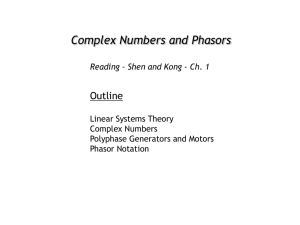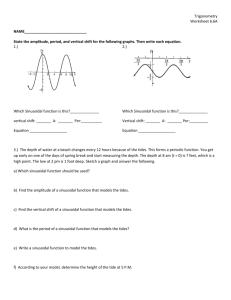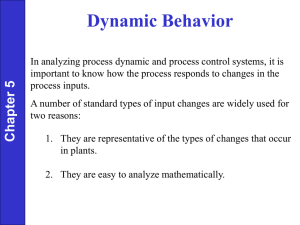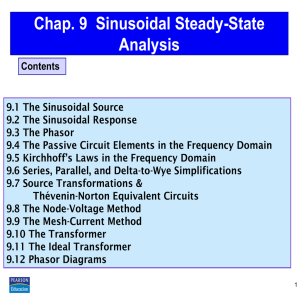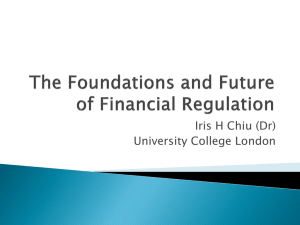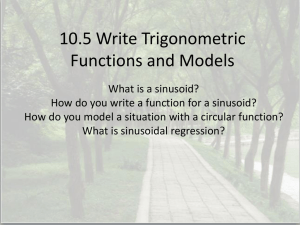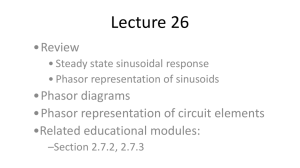Lecture 25 slides
advertisement
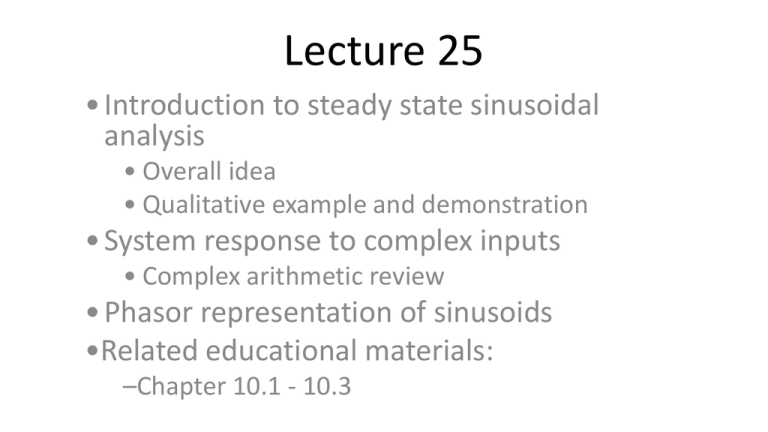
Lecture 25
• Introduction to steady state sinusoidal
analysis
• Overall idea
• Qualitative example and demonstration
• System response to complex inputs
• Complex arithmetic review
• Phasor representation of sinusoids
•Related educational materials:
–Chapter 10.1 - 10.3
Steady state sinusoidal response – overview
• We have examined the natural response and step
response of electrical circuits
• We now consider the forced response of a circuit to
sinusoidal inputs
• We will only consider the steady state response to the
sinusoidal input
• Apply a sinusoidal input and let t
• The steady state sinusoidal response
• Corresponds to the particular solution
Why is this important?
1. Sinusoidal signals are very common
• Power signals commonly sinusoidal (AC signals)
• Carrier signals in communications often sinusoidal
2. The mathematics is considerably simpler
• Differential equations become algebraic
3. System behavior often specified in terms of the
system’s steady-state sinusoidal response
• Example: Audio system specifications
4. It’s “natural” – our senses often work this way
System response to sinusoidal input
• Apply a sinusoidal input, beginning at t = 0
• u(t) = Acos(t + ), t>0
Sinusoidal response of linear systems
• The steady state response of a linear system, to a
sinusoidal input, will be a sinusoid of the same
frequency (particular solution of same form as input)
• The amplitude and phase can change
• These changes are, in general, a function of the frequency
• Demo system response
– Sinusoidal input to tower
– Indicate response: transient, steady-state,
frequency dependence
RL circuit steady state sinusoidal response
• Apply a sinusoidal input to
RL circuit:
u(t) = Acos(t + )
• Governing equation
(t):
• Note on previous slide that di/dt is NOT zero
for steady-state sinusoidal response!
Determining steady state sinusoidal responses
• Obtaining solutions in terms of sines and cosines is
tedious!
• Try a “trick” involving complex exponentials:
Acos(t + ) = Re{Aej(t+)} = Re{Aejejt}
• Look at the response of the system to a complex
exponential input, Aejejt
• Results in a complex exponential response, Bejejt
• The actual input is the real part of the complex input
• The actual output is the real part of the complex output
• Note: Complex exponentials previously discussed
in lecture 21.
– We’ll do a little review, but it may be worthwhile for
you to review lecture 21, if you are insecure about
complex exponentials – we’ll be using them a LOT now
• Point out that complex input not physically
realizable!
RL circuit response – revisited
• Apply a complex exponential
input:
u(t) = Aej ejt
• Governing equation (t)
• Assume form of solution:
• Annotate last bullet of previous slide, to show
di/dt and where terms go in governing
differential equation
RL circuit response to complex input
• Substitute assumed solution into governing equation:
• We can cancel ejt :
• Since [Lej+R] is simply a complex number:
• Note in previous slide:
– In equation 1, we no longer have a differential equation – it’s
algebraic!
– In equation 2, the governing equation is no longer even a
function of time! (The coefficients are, however, functions of
frequency)
• The drawback: complex numbers are now involved. (Point
out in equation 2)
– We will do a little complex arithmetic review in the next few
slides.
Complex numbers – review
• Rectangular coordinates:
Im
Im
• Polar coordinates:
• Relationships:
A = a + jb
b
A
a
Re
Re
Review of complex arithmetic
• Given two complex
numbers:
• Addition:
• Subtraction:
Review of complex arithmetic – continued
• Multiplication:
• Same two complex
numbers:
• Division:
Review of complex arithmetic
• Multiplication:
• Same two complex
numbers, but in polar
form:
• Division:
• Annotate first “division” equation to note that
1/exp(phi) = exp(-phi)
Complex arithmetic – summary
• Addition, subtraction generally easiest in
rectangular coordinates
• Add or subtract real and imaginary parts individually
• Multiplication, division generally easiest in polar
coordinates
• Multiplication: multiply magnitudes, add phases
• Division: divide magnitudes, subtract phases
Phasors
• Recall:
• Complex exponentials can be used to represent sinusoids
• Complex exponentials can be written as a complex
number multiplying a time-varying complex exponential
• The complex number Aej provides the magnitude and
phase of the original sinusoidal signal
Phasors – definition
• The complex number (in polar form) providing the
magnitude and phase of a sinusoidal signal is called
a phasor.
A Ae
j
A
Example
• Use phasors to determine the current i(t) in the circuit below
if Vs(t) = Vmcos(100t).
• In previous slide, show:
– Change of input to complex exponential
– Derivation of governing differential equation.
Example – continued
• The governing differential equation is:
• Since the input has the form V e j100 t , where V is a phasor
representing the input magnitude and phase, the output must
be of the form I e j100 t , where I is a phasor representing the
output magnitude and phase.
• In previous slide, emphasize concepts. Do
substitution and write algebraic equation.
Example – still continued…
• In previous slide, do complex arithmetic to
solve for current phasor; convert back to time
domain.
Example – Time domain signals
• Input:
Vs(t), i(t)
45
Input
• Response:
Time
• The response lags
the input by 45
Response
